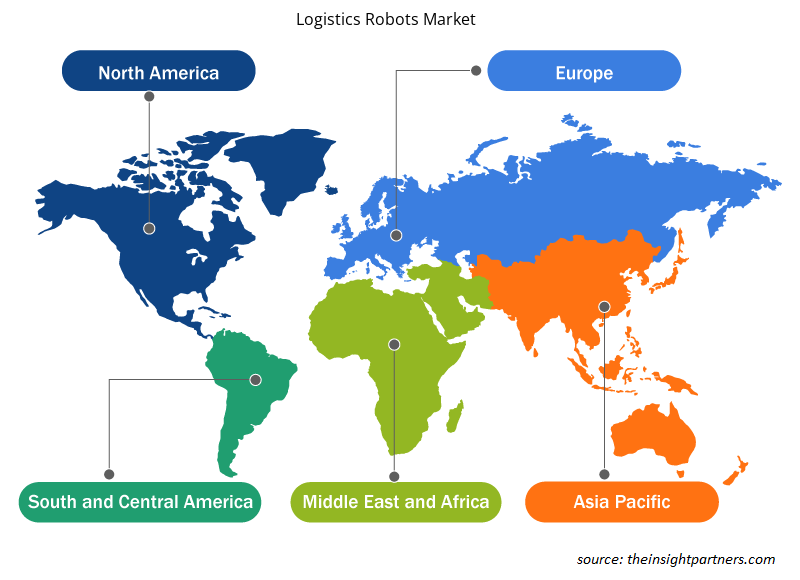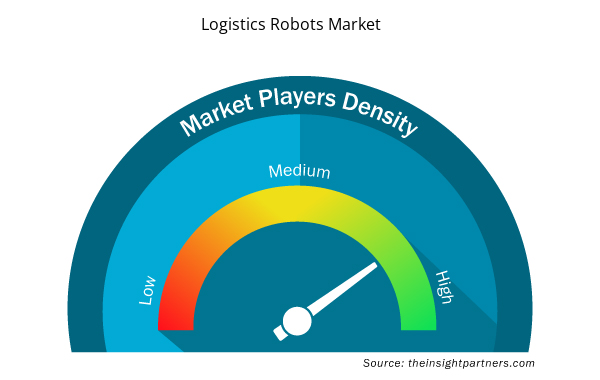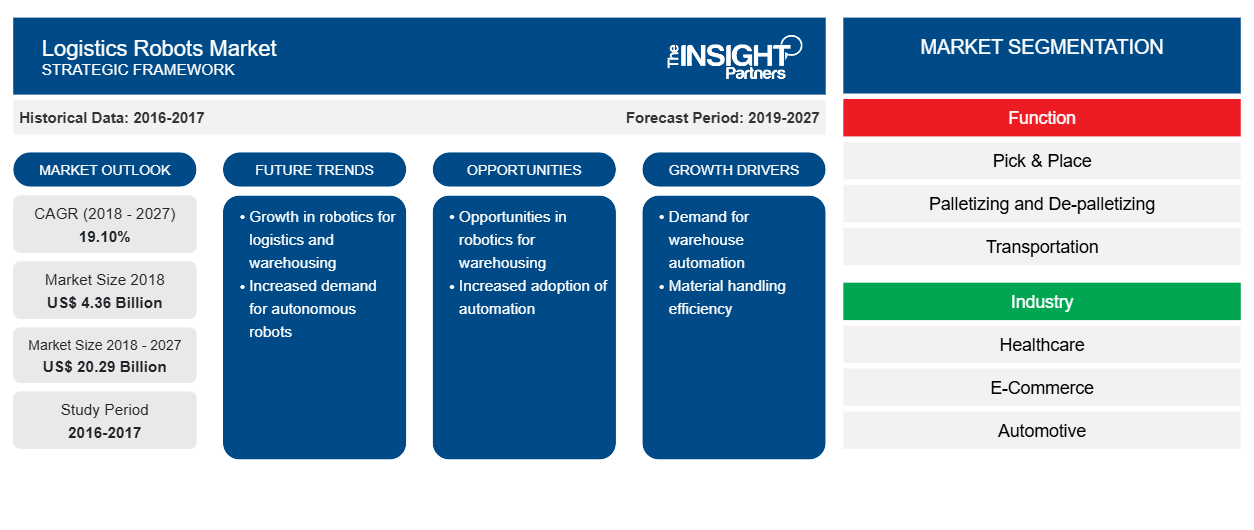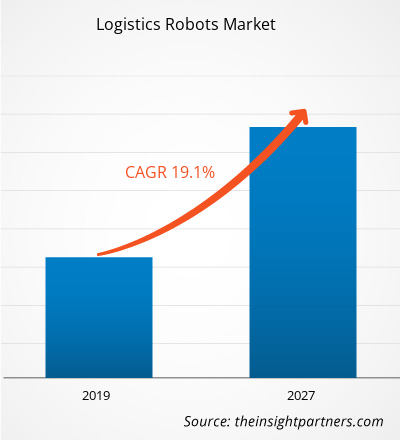بلغت قيمة سوق الروبوتات اللوجستية 4،356.2 مليون دولار أمريكي في عام 2018 ومن المتوقع أن تنمو بمعدل نمو سنوي مركب قدره 19.10٪ من عام 2019 إلى عام 2027 لتصل إلى 20،293.4 مليون دولار أمريكي بحلول عام 2027.
الزيادة في عدد شركات الخدمات اللوجستية والتخزين التي تركز بقوة على دمج الروبوتات للحصول على فوائد الكفاءة المحسنة والسرعة والأرباح المتزايدة للبقاء في المنافسة في السوق. إن اعتماد التكنولوجيا المتقدمة مثل تقنيات التخزين والخدمات اللوجستية الروبوتية ينمو من أجل تعزيز كفاءة التشغيل بسعر مناسب. إن سوق الروبوتات اللوجستية العالمية مدفوع بعوامل مثل النسبة المتزايدة من السكان المسنين على مستوى العالم مما يؤدي إلى نقص العمالة وزيادة شبكات سلسلة التوريد على مستوى العالم، ولكن من المتوقع أن يؤدي الاستثمار الرأسمالي المرتفع لنشر الروبوتات اللوجستية إلى كبح نمو سوق الروبوتات اللوجستية خلال فترة التنبؤ. ومع ذلك، من المرجح أن توفر أتمتة المستودعات المتزايدة والسوق الراسخة في منطقة آسيا والمحيط الهادئ والدول الأوروبية فرص نمو كبيرة لتحسين حصة السوق للاعبين في الصناعة في المستقبل القريب.
رؤى السوق
ارتفاع نسبة السكان المسنين على مستوى العالم يؤدي إلى نقص العمالة
إن النسبة المتزايدة من السكان المسنين في جميع أنحاء العالم هي أحد العوامل الرئيسية للحد من العمالة في مختلف الصناعات. تشهد كل دولة في جميع أنحاء العالم ارتفاعًا في عدد كبار السن في مجتمعها. أصبحت شيخوخة السكان أحد العوامل الجوهرية للتحولات الاجتماعية في القرن الحادي والعشرين في جميع القطاعات، والتي تشمل العمالة وكذلك الأسواق المالية. على الرغم من أن العديد من البلدان مثل إيطاليا واليابان والعديد من البلدان الأخرى هي البلدان التي أدرجت العدد الأقصى لنسبة السكان المسنين، من خلال النظر في نسبة كبيرة من سكانها فوق 65 عامًا. وفقًا لمنظمة الصحة العالمية، من المتوقع أن يكون حوالي 2 مليون شخص حول العالم فوق سن 60 عامًا بحلول عام 2050، وهو ما يمثل ثلاثة أضعاف ما كان عليه في عام 2000. كان الارتفاع في عدد السكان المسنين مسؤولاً عن نقص العمالة. يلعب تنفيذ روبوتات الخدمات اللوجستية في العديد من الصناعات دورًا مهمًا، حيث يقلل من التكلفة الإجمالية للعملية، ويزيد الإنتاجية، ويعزز السلامة، ويقلل من الخطأ البشري. تركز التطورات التكنولوجية السريعة في جميع أنحاء المستودعات على مستوى العالم على المتطلبات المتعلقة بالصعوبات التي تواجهها عملية سلسلة التوريد والتأكد من أن التكنولوجيا المستخدمة مرتبطة بأهداف العمل. كان تنفيذ الروبوتات عبر وحدات ووظائف ومراحل مختلفة في دورات حياة المنتج تحديًا رئيسيًا تواجهه المستودعات اليوم في مسار نموها، مما سيؤدي بدوره إلى تعزيز سوق روبوتات الخدمات اللوجستية في المستقبل القريب.
قم بتخصيص هذا التقرير ليناسب متطلباتك
ستحصل على تخصيص لأي تقرير - مجانًا - بما في ذلك أجزاء من هذا التقرير، أو تحليل على مستوى الدولة، وحزمة بيانات Excel، بالإضافة إلى الاستفادة من العروض والخصومات الرائعة للشركات الناشئة والجامعات
- احصل على أهم اتجاهات السوق الرئيسية لهذا التقرير.ستتضمن هذه العينة المجانية تحليلاً للبيانات، بدءًا من اتجاهات السوق وحتى التقديرات والتوقعات.
رؤى حول أنواع الروبوتات
استحوذ قطاع الروبوتات المتنقلة التعاونية على أكبر حصة في سوق الروبوتات اللوجستية العالمية. يتم نشرها عبر العديد من الصناعات لأداء عدد من المهام مثل التعبئة والتغليف ورعاية الآلات ومناولة المواد، حيث تتمتع هذه الروبوتات التعاونية بالكفاءة الكافية للتعامل مع العمليات الشاقة والخفيفة. إنها دقيقة للغاية ومرنة ودقيقة. علاوة على ذلك، من السهل صيانة الروبوتات التعاونية ويمكن إعادة تكوينها وإعادة برمجتها بسهولة. يمكن لهذه الروبوتات أيضًا التعامل مع العمل الحساس؛ علاوة على ذلك، فهي تعدل نفسها وفقًا للتناقضات التي تحدث أثناء عمليات التصنيع. تتمتع الروبوتات التعاونية بالقدرة على جمع المقاييس المهمة لتوفير التحليل على متن الطائرة، جنبًا إلى جنب مع التقارير، لتبسيط عملية اتخاذ القرار التي تحرك سوق الروبوتات اللوجستية بشكل عام.
رؤى الوظيفة
استحوذ قطاع النقل على أكبر حصة في سوق الروبوتات اللوجستية العالمية. يتم وضع البضائع على المنصات، وهناك اختلاف طفيف في العديد من أشكال وأحجام المنتجات، مما يتطلب الأتمتة لتحميل وتفريغ هذه البضائع. تم دمج الرؤية بالليزر ثلاثية الأبعاد مع برنامج الروبوت الجديد، مما يساعد المستخدمين على رؤية المنتجات المختلفة في الحاويات، وتحديد تسلسل التحميل / التفريغ المثالي، وتنفيذ العملية بدقة عالية. يتم استخدام الروبوتات اللوجستية لتحريك رف الهدف، وسحب السلة ورفعها، وتمديد الشوكة على الرف، وإعادة موضع الهدف مما يدفع سوق الروبوتات اللوجستية بشكل عام.
رؤى الصناعة
استحوذ قطاع الخدمات اللوجستية الخارجية على أكبر حصة في سوق الروبوتات اللوجستية العالمية. يقدم مزودو الخدمات اللوجستية هؤلاء خدمات متنوعة، بما في ذلك التخزين وإدارة المخزون والنقل والتوزيع وتنفيذ الطلبات وتوحيد الشحنات. من المتوقع أن يؤدي الطلب المتزايد باستمرار على إدارة التسليم في الوقت المناسب بالإضافة إلى خفض تكاليف الشحن، إلى تعزيز التركيز على الاحتفاظ بسجل المواد الموجودة في المخزون، والأعمال الأساسية والحد من أصول الشركة، وهو ما سيقود سوق الروبوتات اللوجستية خلال فترة التنبؤ.
تتبنى الشركات عادة عدة استراتيجيات لمبادرات السوق لتوسيع نطاق وجودها في جميع أنحاء العالم وتلبية الطلب المتزايد. وتُتبع هذه الاستراتيجية في الغالب في أوروبا ومنطقة آسيا والمحيط الهادئ. ويتبنى اللاعبون الموجودون في سوق الروبوتات اللوجستية استراتيجية التوسع والاستثمار في البحث والتطوير لتوسيع قاعدة العملاء في جميع أنحاء العالم، وهو ما يسمح أيضًا للاعبين بالحفاظ على اسم علامتهم التجارية عالميًا.
رؤى إقليمية حول سوق الروبوتات اللوجستية
لقد قام المحللون في Insight Partners بشرح الاتجاهات والعوامل الإقليمية المؤثرة على سوق الروبوتات اللوجستية طوال فترة التوقعات بشكل شامل. يناقش هذا القسم أيضًا قطاعات سوق الروبوتات اللوجستية والجغرافيا في جميع أنحاء أمريكا الشمالية وأوروبا ومنطقة آسيا والمحيط الهادئ والشرق الأوسط وأفريقيا وأمريكا الجنوبية والوسطى.

- احصل على البيانات الإقليمية المحددة لسوق الروبوتات اللوجستية
نطاق تقرير سوق الروبوتات اللوجستية
| سمة التقرير | تفاصيل |
|---|---|
| حجم السوق في عام 2018 | 4.36 مليار دولار أمريكي |
| حجم السوق بحلول عام 2027 | 20.29 مليار دولار أمريكي |
| معدل النمو السنوي المركب العالمي (2018 - 2027) | 19.10% |
| البيانات التاريخية | 2016-2017 |
| فترة التنبؤ | 2019-2027 |
| القطاعات المغطاة | حسب الوظيفة
|
| المناطق والدول المغطاة | أمريكا الشمالية
|
| قادة السوق وملفات تعريف الشركات الرئيسية |
|
كثافة اللاعبين في السوق: فهم تأثيرها على ديناميكيات الأعمال
يشهد سوق الروبوتات اللوجستية نموًا سريعًا، مدفوعًا بالطلب المتزايد من المستخدم النهائي بسبب عوامل مثل تفضيلات المستهلكين المتطورة والتقدم التكنولوجي والوعي المتزايد بفوائد المنتج. ومع ارتفاع الطلب، تعمل الشركات على توسيع عروضها والابتكار لتلبية احتياجات المستهلكين والاستفادة من الاتجاهات الناشئة، مما يؤدي إلى زيادة نمو السوق.
تشير كثافة اللاعبين في السوق إلى توزيع الشركات أو المؤسسات العاملة في سوق أو صناعة معينة. وهي تشير إلى عدد المنافسين (اللاعبين في السوق) الموجودين في مساحة سوق معينة نسبة إلى حجمها أو قيمتها السوقية الإجمالية.
الشركات الرئيسية العاملة في سوق الروبوتات اللوجستية هي:
- ايه جي في الدولية
- روبوتات كليرباث
- شركة دايفوكو المحدودة
- شركة فانوك
- شركة فيتش للروبوتات
إخلاء المسؤولية : الشركات المذكورة أعلاه ليست مرتبة بأي ترتيب معين.

- احصل على نظرة عامة على أهم اللاعبين الرئيسيين في سوق الروبوتات اللوجستية
سوق الروبوتات اللوجستية – حسب نوع الروبوت
- الذراع الروبوتية
- مركبة موجهة آليا
- الروبوتات المتنقلة التعاونية
- آحرون
سوق الروبوتات اللوجستية – حسب الوظيفة
- اختر و ضع
- التكديس وتفريغ البضائع من المنصات
- مواصلات
- التغليف
سوق الروبوتات اللوجستية – حسب الصناعة
- الرعاية الصحية
- التجارة الإلكترونية
- السيارات
- الاستعانة بمصادر خارجية للخدمات اللوجستية
- بيع بالتجزئة
- السلع الاستهلاكية
- الأطعمة والمشروبات
- آحرون
سوق الروبوتات اللوجستية – حسب المنطقة الجغرافية
أمريكا الشمالية
- نحن
- كندا
- المكسيك
أوروبا
- فرنسا
- ألمانيا
- إيطاليا
- المملكة المتحدة
- روسيا
- بقية أوروبا
آسيا والمحيط الهادئ
- الصين
- الهند
- كوريا الجنوبية
- اليابان
- أستراليا
- بقية آسيا والمحيط الهادئ
الشرق الأوسط وأفريقيا
- جنوب أفريقيا
- المملكة العربية السعودية
- الامارات العربية المتحدة
- بقية الشرق الأوسط وأفريقيا
أمريكا الجنوبية
- البرازيل
- الأرجنتين
- بقية أمريكا الجنوبية
نبذة عن الشركة
- ايه جي في الدولية
- روبوتات كليرباث
- شركة دايفوكو المحدودة
- شركة فانوك
- شركة فيتش روبوتيكس
- مجموعة كيون ايه جي
- شركة ناب ايه جي
- كولمورجن
- شركة كوكا ايه جي
- شركة توشيبا
- التحليل التاريخي (سنتان)، السنة الأساسية، التوقعات (7 سنوات) مع معدل النمو السنوي المركب
- تحليل PEST و SWOT
- حجم السوق والقيمة / الحجم - عالميًا وإقليميًا وقطريًا
- الصناعة والمنافسة
- مجموعة بيانات Excel



Report Coverage
Revenue forecast, Company Analysis, Industry landscape, Growth factors, and Trends

Segment Covered
This text is related
to segments covered.

Regional Scope
North America, Europe, Asia Pacific, Middle East & Africa, South & Central America

Country Scope
This text is related
to country scope.
الأسئلة الشائعة
Automated guided vehicles (AGVs) are used for consistent as well as predicted transport of materials. AGVs might be serviced through conveyors, forklift trucks, or manual cart transport systems. The transport of bulk materials using AGVs helps minimize efforts required in repetitive transportation of small chunks of materials, with less human intervention. Apart from distribution and manufacturing, AGVs have also become an integral part of other industries, including retail, military, food & beverages, automotive, and healthcare. The deployment of AGVs benefits businesses by reducing the cost of labor required in manual execution of tasks; enhancing safety, accuracy, and productivity of products; and improving the efficiency of work when integrated with the warehouse management/control systems. Improved work efficiencies further helps streamline other processes, such as materials ordering and inventory management.
With the increasing importance of equipment in logistic markets in APAC, especially China and India, robot manufacturers realize that electronics innovations can complement production innovations in gaining a competitive advantage. Japan is a well-developed economy and is one of the most technologically advanced economies across the world. Also, the region has a few significant manufacturers of robots and factory automation systems such as Fanuc, Mitsubishi Electric, and Omron Corp, among others. The Japanese companies widely use automation solutions to maintain their competitive position in the market.
The continuous growth in consumer expectations is likely to drive continued investment for the adoption of logistics robots for performing operational functions in warehouses. Leveraging the modern supply chain technology as well as the Internet of Things (IoT), the focus on the “smart warehouse†concept is growing, which can serve as a hub to enhance the efficiency and speed of the entire supply chain process. The warehouse automation includes wearable wore by workers to sensors, logistics robots, internet-enabled devices, and smart equipment, which profoundly modify the logistics management. Warehouse management is constantly facing more pressures related to supply chain transformation, commoditization, and rising customer expectations. Therefore, the warehouse automation concept is an effective way to enhance efficiencies, reduce operational costs, and scale operations. The warehouse automation performs various activities such as data collection and inventory control, with million-dollar of investments.
The List of Companies - Logistics Robots Market
- AGV International
- Clearpath Robotics
- Daifuku Co. Ltd.
- Fanuc Corporation
- Fetch Robotics Inc
- KION GROUP AG
- KNAPP AG
- Kollmorgen
- Kuka AG
- Toshiba Corporation
The Insight Partners performs research in 4 major stages: Data Collection & Secondary Research, Primary Research, Data Analysis and Data Triangulation & Final Review.
- Data Collection and Secondary Research:
As a market research and consulting firm operating from a decade, we have published and advised several client across the globe. First step for any study will start with an assessment of currently available data and insights from existing reports. Further, historical and current market information is collected from Investor Presentations, Annual Reports, SEC Filings, etc., and other information related to company’s performance and market positioning are gathered from Paid Databases (Factiva, Hoovers, and Reuters) and various other publications available in public domain.
Several associations trade associates, technical forums, institutes, societies and organization are accessed to gain technical as well as market related insights through their publications such as research papers, blogs and press releases related to the studies are referred to get cues about the market. Further, white papers, journals, magazines, and other news articles published in last 3 years are scrutinized and analyzed to understand the current market trends.
- Primary Research:
The primarily interview analysis comprise of data obtained from industry participants interview and answers to survey questions gathered by in-house primary team.
For primary research, interviews are conducted with industry experts/CEOs/Marketing Managers/VPs/Subject Matter Experts from both demand and supply side to get a 360-degree view of the market. The primary team conducts several interviews based on the complexity of the markets to understand the various market trends and dynamics which makes research more credible and precise.
A typical research interview fulfils the following functions:
- Provides first-hand information on the market size, market trends, growth trends, competitive landscape, and outlook
- Validates and strengthens in-house secondary research findings
- Develops the analysis team’s expertise and market understanding
Primary research involves email interactions and telephone interviews for each market, category, segment, and sub-segment across geographies. The participants who typically take part in such a process include, but are not limited to:
- Industry participants: VPs, business development managers, market intelligence managers and national sales managers
- Outside experts: Valuation experts, research analysts and key opinion leaders specializing in the electronics and semiconductor industry.
Below is the breakup of our primary respondents by company, designation, and region:

Once we receive the confirmation from primary research sources or primary respondents, we finalize the base year market estimation and forecast the data as per the macroeconomic and microeconomic factors assessed during data collection.
- Data Analysis:
Once data is validated through both secondary as well as primary respondents, we finalize the market estimations by hypothesis formulation and factor analysis at regional and country level.
- Macro-Economic Factor Analysis:
We analyse macroeconomic indicators such the gross domestic product (GDP), increase in the demand for goods and services across industries, technological advancement, regional economic growth, governmental policies, the influence of COVID-19, PEST analysis, and other aspects. This analysis aids in setting benchmarks for various nations/regions and approximating market splits. Additionally, the general trend of the aforementioned components aid in determining the market's development possibilities.
- Country Level Data:
Various factors that are especially aligned to the country are taken into account to determine the market size for a certain area and country, including the presence of vendors, such as headquarters and offices, the country's GDP, demand patterns, and industry growth. To comprehend the market dynamics for the nation, a number of growth variables, inhibitors, application areas, and current market trends are researched. The aforementioned elements aid in determining the country's overall market's growth potential.
- Company Profile:
The “Table of Contents” is formulated by listing and analyzing more than 25 - 30 companies operating in the market ecosystem across geographies. However, we profile only 10 companies as a standard practice in our syndicate reports. These 10 companies comprise leading, emerging, and regional players. Nonetheless, our analysis is not restricted to the 10 listed companies, we also analyze other companies present in the market to develop a holistic view and understand the prevailing trends. The “Company Profiles” section in the report covers key facts, business description, products & services, financial information, SWOT analysis, and key developments. The financial information presented is extracted from the annual reports and official documents of the publicly listed companies. Upon collecting the information for the sections of respective companies, we verify them via various primary sources and then compile the data in respective company profiles. The company level information helps us in deriving the base number as well as in forecasting the market size.
- Developing Base Number:
Aggregation of sales statistics (2020-2022) and macro-economic factor, and other secondary and primary research insights are utilized to arrive at base number and related market shares for 2022. The data gaps are identified in this step and relevant market data is analyzed, collected from paid primary interviews or databases. On finalizing the base year market size, forecasts are developed on the basis of macro-economic, industry and market growth factors and company level analysis.
- Data Triangulation and Final Review:
The market findings and base year market size calculations are validated from supply as well as demand side. Demand side validations are based on macro-economic factor analysis and benchmarks for respective regions and countries. In case of supply side validations, revenues of major companies are estimated (in case not available) based on industry benchmark, approximate number of employees, product portfolio, and primary interviews revenues are gathered. Further revenue from target product/service segment is assessed to avoid overshooting of market statistics. In case of heavy deviations between supply and demand side values, all thes steps are repeated to achieve synchronization.
We follow an iterative model, wherein we share our research findings with Subject Matter Experts (SME’s) and Key Opinion Leaders (KOLs) until consensus view of the market is not formulated – this model negates any drastic deviation in the opinions of experts. Only validated and universally acceptable research findings are quoted in our reports.
We have important check points that we use to validate our research findings – which we call – data triangulation, where we validate the information, we generate from secondary sources with primary interviews and then we re-validate with our internal data bases and Subject matter experts. This comprehensive model enables us to deliver high quality, reliable data in shortest possible time.


 احصل على عينة مجانية لهذا التقرير
احصل على عينة مجانية لهذا التقرير